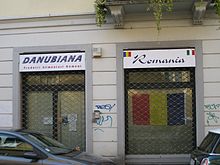
Back Rumänen in Italien German Inmigración rumana en Italia Spanish Romeni in Italia Italian Românii din Italia Romanian
| Total population | |
|---|---|
| 1,081,836 Romanian citizens (2023)[1] 194,480 Moldovan citizens (2020)[1] | |
| Regions with significant populations | |
| Rome, Turin, Milan, Bologna, Padua, Verona, Florence, Guidonia Montecelio, Aprilia, Venice[2] | |
| Languages | |
| Italian, Romanian | |
| Religion | |
| Predominantly Orthodox Christianity; also Roman Catholicism[3] | |
| Related ethnic groups | |
| Romanian people, Romanian diaspora, Romanian Britons, Romanian Australians, Romanian Americans, Romanian Canadians, Romanian French people, Romanian Spanish people |
| Part of a series of articles on |
| Romanians |
|---|
 |
Romanians in Italy (Romanian: românii din Italia; Italian: romeni in Italia or rumeni in Italia) became a significant population after 1999, due to a large wave of emigration known in Romania as Fenomenul migrației către UE (the phenomenon of migration toward the European Union). A large part of Romanian emigrants went to Spain or Italy, whose national languages are Romance languages like Romanian. They were followed by another wave beginning in 2002, when Romanian citizens obtained the right to move to any Schengen Zone country without a visa. In 2007 Romania joined the European Union, further increasing the economic and political ties between the countries.
As of 2023[update], there were 1,081,836 Romanian citizens living in Italy, the largest Romanian immigrant population in any country as well as the largest immigrant group within Italy.[4]
Between 2008 and 2020, 98,499 Romanians acquired Italian citizenship.[5]

- ^ a b Cite error: The named reference
:0was invoked but never defined (see the help page). - ^ "Statistiche: Romeni in Italia".
- ^ "Appartenenza e pratica religiosa tra i cittadini stranieri". 4 September 2019.
- ^ http://dati.istat.it/Index.aspx?DataSetCode=DCIS_POPSTRRES1 [bare URL]
- ^ "Acquisizioni di cittadinanza". dati.istat.it (in Italian).